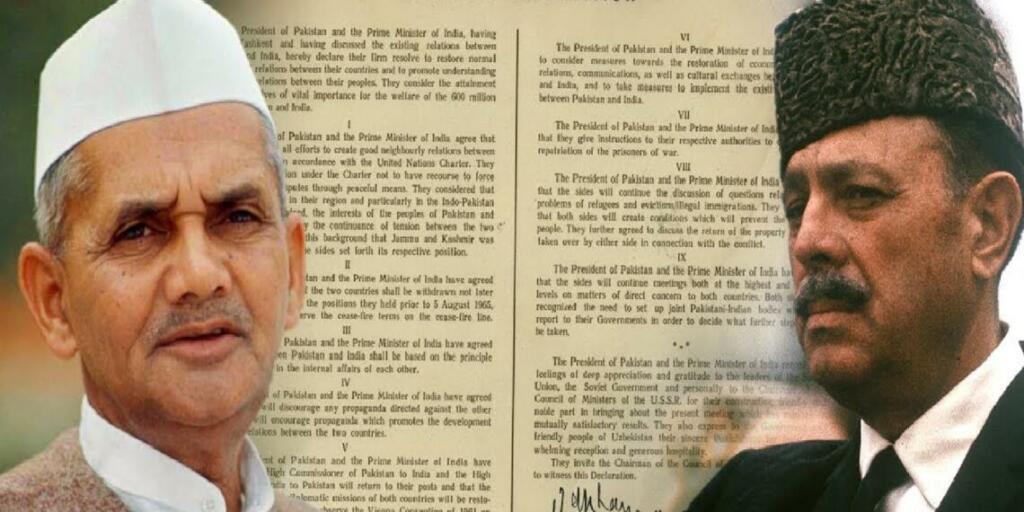You might have heard of the Tashkent Declaration. If not, you might have seen the film ‘The Tashkent Files’ directed by Vivek Agnihotri. For the unversed, The Tashkent Declaration was a peace agreement between India and Pakistan signed on 10 January 1966 that resolved the Indo-Pakistani War of 1965. However, the peace agreement later turned into a mental war that India is fighting even now as the reason behind the unnatural death of Shri Lal Bahadur Shastri after signing the agreement is still a mystery.
What is the Tashkent Declaration?
A meeting for a peace agreement between India and Pakistan to resolve the Indo-Pakistani War of 1965, was held in Tashkent in the Uzbek Soviet Socialist Republic, Soviet Union (now Uzbekistan) from 4 to 10 January 1966. It aimed at creating a more permanent settlement.
Premier Aleksey Kosygin, moderated between Indian Prime Minister Lal Bahadur Shastri and Pakistani President Muhammad Ayub Khan attended the meeting. A declaration was released hoping that Indian and Pakistani forces would pull back to their pre-conflict positions. Moreover, the declaration also stated that after 25 February 1966; neither of the nations would interfere in each other’s internal affairs and economic and diplomatic relations would be restored. It was agreed between both countries that leaders would work towards improving bilateral relations.
What happened after signing the agreement?
What really happened after a few hours of signing the agreement, shook the nation. However, it remains shrouded in mystery, all thanks to the gratuitous state secrecy that our government resorted to.
It was around 4 pm on January 10, Prime Minister Shastri reached the villa after signing the agreement. He had a light meal that night which was cooked by Jan Mohammad, the personal cook of TN Kaul, the Indian ambassador to Moscow.
At around 11.30 pm, Shastri drank a glass of milk that was served by the ambassador’s cook. But around 1.25 am on January 11, he woke up, coughing severely. He went to another room to ask his staff to inform his personal doctor RN Chugh as he had no phone or intercom in his room. Shastri was dying by the time Doctor Chugh arrived. He supposedly had a heart attack and Dr Chugh could do not anything at that time. Shastri, during his last moments, took Lord Ram’s name and passed away.
The sudden death led to several conspiracy theories. Had it been some other country, such a mysterious death would have been inquired into by authorities long ago and all relevant documents placed in the public domain.
But, the Indian government at that time, refused to publish a report on his death as they believed that this could harm foreign relations. Moreover, it claimed that the reports can cause “disruption in the country” and a breach of parliamentary privileges.
Things took an even worse turn when Ayub Khan refused to comment and isolated himself instead of announcing the reasons for signing the agreement.
Why late PM Shastri’s death is suspicious?
There are certain reasons that make everything about his death suspicious. At 4 am, Ahmed Sattarov, the Russian butler attached to Shastri, was handcuffed by an officer of the Ninth Directorate of the KGB. Sattarov has told that the KGB officer “said that they suspected the Indian prime minister had been poisoned”.
In addition to that, when Shastri’s body was brought to Delhi, his mother had also screamed that someone had poisoned her son as there were strange blue patches on Shastri’s body, “Mere bitwa ko jahar de diya!”
Raed more: Honest Review: Vivek Agnihotri’s The Tashkent Files is the boldest political movie in Hindi
The family also sought clarification and action from the government but nothing could be done could satisfy them. Even when they demanded a post-mortem on his body, it was neglected by the Government.
Vivek Agnihotri, with The Tashkent Files, had come up with a highly political movie to unveil the truth that has troubled the average Indian citizen for the last 50 years but was politically brushed under the carpet.
However, Shastri Ji also needed to be recognised as the visionary leader he was who brought in Green Revolution, White Revolution and encouraged Nuclear programme. Many Indian generations never got to know him because these pages were simply torn out of contemporary history.
